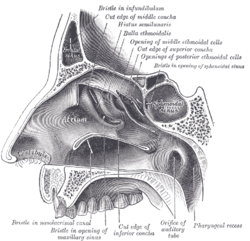Sphenoid sinus
| Sphenoid sinus | |
|---|---|
 Lateral wall of nasal cavity; the three nasal conchæ have been removed. (Sphenoidal sinus visible at upper right, in dark circle.) | |
 Nose and nasal cavities. (Sphenoid sinus labeled at upper right.) | |
| Details | |
| Nerve | posterior ethmoidal nerves, and orbital branches of the pterygopalatine ganglion |
| Identifiers | |
| Latin | sinus sphenoidalis |
| MeSH | D013101 |
| TA98 | A06.1.03.003 |
| TA2 | 3178 |
| FMA | 54683 |
| Anatomical terms of bone | |
The sphenoid sinus is a paired paranasal sinus occurring within the
Structure

On average, a sphenoid sinus measures 2.2 cm vertical height, 2 cm in transverse breadth; and 2.2 cm antero-posterior depth.[3]
Each spehoid sinus is contained within the body of sphenoid bone, being situated just inferior to the sella turcica. The two sphenoid sinuses are separated medially by the septum of sphenoidal sinuses (which is usually asymmetrical).[2]: 500
An opening of sphenoidal sinus forms a passage between each sphenoidal sinus,[2]: 500 and the nasal cavity. Posteriorly, an opening of sphenoidal sinus opens into the sphenoidal sinus by an aperture high on the anterior wall the sinus; anteriorly, an opening of sphenoidal sinus opens into the roof of the nasal cavity via an aperture on the posterior wall of the sphenoethmoidal recess (occurring just superior the choana).[4]
Innervation
The mucous membrane receives sensory[citation needed] innervation from the posterior ethmoidal nerve (branch of the ophthalmic nerve (CN V1)), and branches of the maxillary nerve (CN V2).[5]
Anatomical relations
Proximal structures include: the
Anatomical variation
The sphenoid sinuses vary in size and shape, and, owing to the lateral displacement of the intervening septum of sphenoid sinuses, are rarely symmetrical.[3]
When exceptionally large, the sphenoid sinuses may extend into the roots of the
The septum of the sphenoidal sinuses may be partially or completely absent. Additional incomplete septa may also be present.[2]: 500
Development
The sphenoidal sinuses are minute at birth;[3][4] their main development takes place after puberty.[4]
Clinical significance
The sphenoid sinuses cannot be palpated on physical examination.
A potential complication of sphenoidal sinusitis is cavernous sinus thrombosis.[7]
If a fast-growing tumor erodes the floor of the sphenoidal sinus, the
An endonasal surgical procedure called a sphenoidotomy may be carried out to enlarge the sphenoid sinus, usually in order to drain it.[8]
Of note, the sphenoid sinus should be distinguished from an Onodi cell, an anatomic variant that is the posterior-most ethmoidal air cell. Onodi cells typically extend posteriorly to lie superolateral to the sphenoid sinus and thus in close proximity to the optic nerve and internal carotid artery.[9] Failure to recognize an Onodi cell on CT scan prior to surgery may put these structures at risk. One study found that an Onodi cell was present 26.6% and 19.1% in males and females, respectively.[6]
Transsphenoidal surgery
Because only thin shelves of bone separate the sphenoidal sinuses from the nasal cavities below and
References
![]() This article incorporates text in the public domain from page 998 of the 20th edition of Gray's Anatomy (1918)
This article incorporates text in the public domain from page 998 of the 20th edition of Gray's Anatomy (1918)
- ^ a b Illustrated Anatomy of the Head and Neck, Fehrenbach and Herring, Elsevier, 2012, page 64
- ^ OCLC 1082911887.)
{{cite book}}: CS1 maint: location missing publisher (link) CS1 maint: others (link - ^ a b c d e Gray, Henry (1918). Gray's Anatomy (20th ed.). pp. 998–999.
- ^ a b c Human Anatomy, Jacob, Elsevier, 2008, page 211
- OCLC 1044772257.)
{{cite book}}: CS1 maint: location missing publisher (link - ^ S2CID 49331277.
- ^ PMID 31289629.
- ^ PMID 19004262.
- ^ Gaillard, Frank. "Sphenoethmoidal air cell | Radiology Reference Article | Radiopaedia.org". Radiopaedia. Retrieved 2023-11-12.
External links
- Anatomy photo:33:st-0712 at the SUNY Downstate Medical Center
- lesson9 at The Anatomy Lesson by Wesley Norman (Georgetown University) (latnasalwall3)
